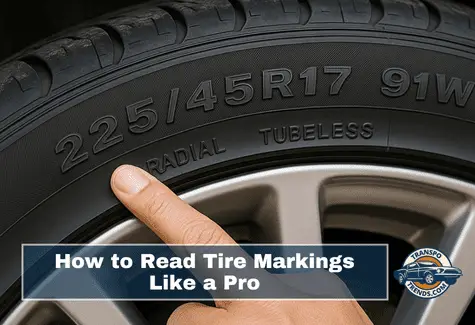Tires are often overlooked until something goes wrong. A sudden blowout. Poor grip on wet roads. Uneven treadwear.
Many of these problems can be prevented if you understand what your tire is telling you. Yes, your tires are talking—through a series of numbers, letters, and symbols molded right into their sidewalls.
This guide will help you decode your tire’s story, from its speed limits to when it was born, and everything in between.
Whether you are buying a replacement or just checking for safety, learning how to read these markings gives you the power to choose wisely and drive confidently.
1. Load Index and Speed Rating
You might have seen something like “99V” on your tire and wondered what it means. Let us break it down.
- “99” is the Load Index.
This number tells you how much weight each tire can carry at maximum pressure. A load index of 99 means the tire can safely carry 775 kilograms. For a vehicle with four tires, that totals up to 3,100 kilograms—plenty for most sedans and crossovers. - “V” is the Speed Rating.
The letter indicates the maximum speed the tire can handle under that load. In this case, “V” means a top speed of 240 kilometers per hour. Exceed this limit and the tire can overheat, deform, or burst—especially under high temperatures or heavy loads.
Refer to this chart to see how speed ratings compare:
| Label | Speed Limit |
|---|---|
| K | 110 km/h |
| L | 120 km/h |
| M | 130 km/h |
| N | 140 km/h |
| P | 150 km/h |
| Q | 160 km/h |
| R | 170 km/h |
| S | 180 km/h |
| T | 190 km/h |
| U | 200 km/h |
| H | 210 km/h |
| V | 240 km/h |
| W | 270 km/h |
| Y | 300 km/h |
| ZR | Over 240 km/h |
As you can see, not all tires are built for speed. Always check your vehicle’s manual to confirm the recommended speed rating.
2. Production Date
Every tire has a birth date, and you can find it on the sidewall inside a small oval. It looks like a four-digit number—for example, 4422.
- The first two digits (44) mean the week of production.
- The last two digits (22) represent the year.
So, 4422 means your tire was manufactured in the 44th week of 2022, around late October or early November.
Why does this matter? Because rubber degrades over time, even if the tire looks unused. Most manufacturers recommend replacing tires that are more than 6 years old, regardless of tread depth. Heat, humidity, and UV rays all accelerate aging.
If you are buying used or discounted tires, checking this date is non-negotiable.
3. Treadwear Rating
The Treadwear Rating is part of the Uniform Tire Quality Grading (UTQG) system, which helps consumers compare tires across brands. You will typically see it printed as TREADWEAR 300, 400, or even higher.
This number is relative, not absolute. A tire with a treadwear of 400 is expected to last twice as long as one rated at 200 under standard test conditions.
For family vehicles or daily drivers, look for a treadwear rating of 300 or higher. That gives you a good balance between durability and performance. Performance tires often have lower treadwear numbers because they prioritize grip over longevity.
Tip: If you live in a hot or rugged climate, higher treadwear ratings usually mean better endurance under stress.
4. Traction Rating: Will It Hold Its Ground?
Next, look for the Traction Grade. This is a letter—AA, A, B, or C—and it refers to the tire’s ability to stop on wet pavement.
- AA: Exceptional grip
- A: Good grip (industry standard)
- B: Average grip
- C: Bare minimum allowed by law
Most reliable tires should have a rating of A or AA. If you often drive in rainy or slippery conditions, this is a key safety factor.
A tire with poor traction may not stop when you need it to. Always check for this rating before buying—especially online.
5. Temperature Rating
The last major marking to understand is the Temperature Grade—either A, B, or C.
- A: Best resistance to heat buildup
- B: Moderate resistance
- C: Minimum safety standard
Heat is a tire’s worst enemy. Under-inflation, highway speeds, and high ambient temperatures all cause rubber to heat up. Without adequate resistance, the internal structure weakens, and a blowout becomes a real risk.
Always choose A-rated tires for temperature if you drive long distances, in warm climates, or carry heavy loads.
The Secret Power of Reading Your Tire
Putting all of this together gives you powerful insight into your vehicle’s safety and performance. For example, a tire labeled “99V TREADWEAR 400 TRACTION A TEMPERATURE A 4422” tells you:
- Load capacity of 775 kg
- Speed safe up to 240 km/h
- Durable enough for daily use
- Good grip in wet weather
- Strong heat resistance
- Manufactured in late 2022
This is not just a piece of rubber. It is a precision tool—and your first line of defense on the road.
Frequently Overlooked Details You Should Never Miss
Mismatched Speed Ratings
Never mix tires with different speed ratings on the same vehicle. It creates imbalance during high-speed driving and compromises safety.
Low Treadwear on Highways
Avoid using tires with treadwear below 300 for long highway commutes. The lower the rating, the faster it will wear out—and the sooner you will need replacements.
Buying Tires Online? Ask for the DOT Code
Many online retailers do not display the production date. Always request the full DOT code to make sure you are not buying an old stock tire.
Final Thoughts
Reading your tire’s sidewall is like reading a resume. It tells you about strength, stamina, character—and potential.
From the speed rating to the traction grade, every letter and number exists for your safety. Understanding them is not just useful; it is essential.
So the next time you are inspecting your tires or buying new ones, take a moment to check:
- Is the speed rating appropriate for my car?
- Is the treadwear above 300 for daily driving?
- Is traction graded A or higher?
- Is the temperature grade A?
- Was it manufactured recently?
With this knowledge in your back pocket, you will never again buy blindly. Your tires may be round and black—but what they carry is your family, your cargo, and your peace of mind.

